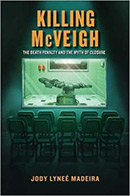Killing McVeigh: The Death Penalty and the Myth of Closure

Author: Jody Lynee Madeira
Publisher: New York: New York University Press, 2012. 336p.
Reviewer: Talia Roitberg Harmon | March 2013
Jody Lynee Madeira’s Killing McVeigh: The Death Penalty and the Myth of Closure marks an important, comprehensive, and insightful analysis into the effect of the 1995 Oklahoma City bombing on the victims—both survivors and family members of those murdered. This ground-breaking book provides a qualitative examination based on extensive interviews the author conducted with 33 victims— hereafter referred to as “participants”– that focused on their experiences, thoughts, and reactions, beginning with Timothy McVeigh’s “perp walk” and ending with the execution of McVeigh and the release of his interview tapes in 2010.
Professor Madeira begins the book with the victims’ reactions to McVeigh’s perp walk, which marked the start of the victim-offender relationship. She discusses the beginning of what she calls his toxic presence in the lives of the victims and his cold, unemotional, and defiant persona. She also addresses the incessant media coverage of McVeigh’s image and the devastating impact it had on the victims and their ability to process the tragedy. One of the main strengths throughout the book is the use of quotes from the participants that help to develop her specific themes.
An additional strength of the book is the author’s successful reconceptualization of the term “closure”. She re-defines it as “memory work” or an “interactive process by which individual family members and survivors construct meaningful narratives of the bombing and its impact on their lives, and how they have moved on, dealt with, adjusted to, or healed from this culturally traumatic event” (p. 38). She discusses the importance of the term closure in the legal context, referring to the Supreme Court decision Payne v. Tennessee. She explains that participants rejected the definition of closure as absolute finality and believed that the media was largely responsible for using this buzz term, but which was not realistically attainable. Instead, participants believed that closure should be defined as a process of coping, which was possible primarily through individual and collective memory work, or the process of compartmentalizing, contextualizing and organizing emotions through narratives. Madeira then addresses the pros and cons of the claim that both the media and the criminal justice system provided the survivors and victims with the venues for them to accomplish memory work.
As a result of the disturbing effect of McVeigh’s presence, many of the victims turned to support groups, spiritual organizations, and therapy. Madeira details a description of the formation of four different community/advocacy groups by the victims: the Oklahoma City Murrah Federal Building Memorial Task Force, which was responsible for building a national memorial; the habeas group, which was responsible for altering the appellate process in capital cases through the creation of a law entitled the Antiterrorism and Effective Death Penalty Act (AEDPA) of 1996; the Oklahoma City Murrah Building Survivor’s Association, which was responsible for community service activities; and Families and Survivors United, which was responsible for victims’ rights advocacy. The main purposes of these groups were to provide companionship, build group narratives, and form reconstructive goals. Madeira discusses some of the internal tensions among the victims, particularly the friction between the survivors and the murdered victims’ family members, the (less poignant) friction between the survivors who sustained injuries and the survivors who did not sustain injuries, and between those victims who supported the death penalty for the perpetrators and those who were opposed to it. However, the majority of those participants who became involved in the community/advocacy groups felt that their activities were very cathartic and more therapeutic in assisting in their memory work than what either the media or the criminal justice system provided. They believed that the groups helped them to regain control of their lives. Moreover, as a result of their advocacy efforts within the groups, several of the participants became career advocates; they have remained involved in advocacy work many years after the bombing.
Another unique facet of the book is when Madeira offers an objective analysis of the ways the media both helped and hindered the victims’ ability to take control of their memory work. For example, some of the benefits included an opportunity for victims to express their views, advocate for causes, set the record straight, and conduct media interviews that many found therapeutic. On the other hand, some felt that media interviews were draining, that some reporters were overly demanding or had their own agendas, and that the media relentlessly replayed certain disturbing images, including McVeigh’s perp walk and footage of the Murrah building ruins. A common impression was that the media coverage was sensationalized, inadequate, distorted, and incorrect. The discussion here is perhaps one of the most important and insightful parts of the book, especially her analysis of the intense media coverage of McVeigh as his execution date drew near. This coverage was most disturbing to the participants and it never answered the most pressing question that victims were asking: Why did he commit this heinous crime?
The author explains that while all the victims wanted McVeigh to be held accountable for the bombing in some way, they held diverse opinions on matters such as participation in the legal proceedings, including attendance at the trials, appropriate sentences, including capital punishment for McVeigh, and attendance at McVeigh’s execution. Many of those who chose to attend and bear witness at McVeigh’s trial found that to be helpful in engaging in memory work, thereby aiding the healing process, and ultimately in serving justice. They also found that, in contrast to the media coverage, the legal proceedings provided them with unbiased information about McVeigh. Madeira points out some initial obstacles to the victims in regard to attending McVeigh’s trial, including a change of venue, the refusal to have the trial broadcast via closed-circuit television back to Oklahoma City, and a limitation on victim impact evidence. She discusses the role (or lack thereof) of emotions in the legal process and how Congress helped to ensure that the victims would be allowed to watch the closed-circuit broadcast of the trial and to attend the guilt phase of the trial if providing victim impact testimony at sentencing. A total of 38 victim impact witnesses testified at the sentencing phase of McVeigh’s trial and confirmed their initial impression of him as cold, callous, remorseless, and defiant. Ultimately, McVeigh’s guilty verdict and death sentence helped many of them with their memory work and healing process.
In a compelling section of the book, Madeira discusses the impact of the legal proceedings for McVeigh’s collaborators–Terry Nichols and Michael Fortier, as well as the effect of the McVeigh jurors’ visit to Oklahoma City. Because these two were more cooperative and remorseful than McVeigh, and because they garnered less media publicity, they were viewed as less offensive than McVeigh by a majority of the participants. Moreover, many felt that Nichols’s courtroom demeanor was the opposite of McVeigh’s: emotional, remorseful, ashamed and sensitive. Ultimately, the jurors were unable to agree on Nichols’s sentence and the judge had no option but to sentence him to life in prison without parole. Madeira explains that Nichols was also tried in state court—the main reason was to hold him accountable for all 168 victims, not merely for the 8 victims covered under the federal trial. However, most participants felt that the state trial was just a “re-run” of the federal trial, and did not alter the sentence of life without parole which was disappointing to them. Fortier apologized for his role in the crime and received a 12 year sentence. Participants felt this was a very light sentence, but a worthwhile price to pay for him providing testimony against McVeigh and Nichols. In an interesting and touching section, the author discusses the McVeigh jurors’ visit to Oklahoma City after Nichols’s trials were over to meet the victims. Ultimately, strong and enduring friendships were formed and proved to be very therapeutic to both groups.
Madeira explains that only eight victims were allowed to attend McVeigh’s execution. Others were able to witness the execution through closed-circuit television to help with their healing and memory work—not for vengeance. Most participants did not feel a duty or responsibility to view the execution. Yet for a minority, there was a need to see justice done, or to witness the conclusion of the legal proceedings and thus further their memory work. An interesting section on forgiveness suggests that, paradoxically, a majority of participants were able to forgive McVeigh: the explanation for this was that the act of forgiving was employed for its own therapeutic value.
Madeira provides balance to the book by detailing a fascinating portrait of McVeigh. This is the highlight of the book. Based on numerous sources, she offers some insight into McVeigh’s motivation for committing the crime and she provides a detailed account of McVeigh’s execution and the impact it had on both the live and remote witnesses. For example, the remote witnesses remained silent during the execution, while the live witnesses were somewhat raucous. She discusses the role of silence in the execution: witnesses’ silence, McVeigh’s silence (he offered no last words, which was seen as defiant and remorseless), and the execution as a means of silencing McVeigh and the media, which provided most victims with relief. Many victims reached new stages in their memory work with the culmination of McVeigh’s execution. However, a minority of victims who were against the death penalty did not get relief from McVeigh’s execution. Moreover, many witnesses were upset by the lack of pain, the speedy process, and the overall ease of McVeigh’s passing.
In the conclusion, Madeira discusses the airing of the McVeigh tapes, the documentary on MSNBC in 2010, and the formation of the memorial/museum (including a focus on the controversial inclusion of the perpetrators in the memorial). Originally, only one sketch of McVeigh was included in the museum. However, this expanded over the years to include additional exhibits regarding the perpetrators in what has been termed “the dark side” of the museum. According to participants, the most important goal of the memorial was to make sure that the victims of the bombing are never forgotten. This part of the book may compel some readers to want to visit the memorial.
Killing McVeigh: The Death Penalty and the Myth of Closure is a well written, interesting, sensitive, compassionate, and thought provoking case study of the Oklahoma City bombing. Its main strength is the depth of the interviews with the participants and the direct quotations that are used throughout the book to flesh out the author’s main themes. In sum, the book is a significant contribution to the fields of victimology, criminology, and capital punishment. It deserves a wide readership, including academics, students, victims’ rights activists, politicians, and anyone in the general public who is interested in learning more about the impact of the Oklahoma City bombing.
Talia Roitberg Harmon, Niagara University, Professor, Department of Criminology and Criminal Justice, tharmon@niagara.edu


